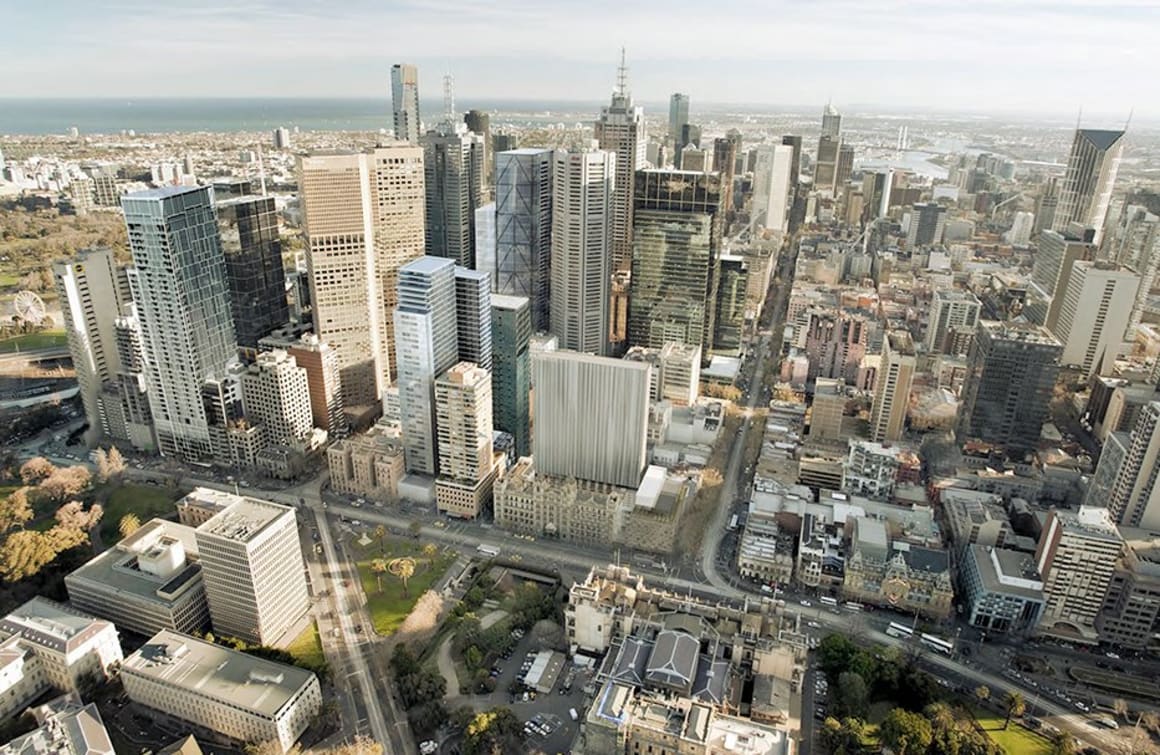85 Spring Street and the East Enders

With much of the CBD's development in recent years concentrated within the western and northern bounds of the Hoddle Grid, one could be forgiven for believing the east end has been largely forgotten.
Currently under planning assessment, 85 Spring Street represents the latest in a cluster of high-rise towers set to redefine the vista from State Parliament. 85 Spring Street is a DCM-designed residential tower for Grocon, joining CBUS's 35 Spring Street in taking advantage of views over Treasury Gardens that will never be built out. Furthermore the Windsor Hotel and Nauru House redevelopments will soon enough join the recently completed 27 Little Collins Street in bringing a new dynamic to this historic end of Melbourne.
I have taken the liberty of photoshopping the nominated towers into dual DCM images provided within 85 Spring Street's design report submitted as part of the planning application; these were originally illustrated as grey massing models.
The 37-storey tower is proposed to reach a height of 128m (137.45m to the top of plant), occupying an irregular L-shape block with frontages to Little Collins Street and Spring Street. Due to Parliament Station's entrance at the Spring Street interface, the site boundary is setback approximately 15 metres from Spring Street.
A 14-storey office tower currently on site would make way to allow for the construction of 330 apartments (136 x 1 bedroom, 190 x 2 bedroom and 4 x 3 bedroom apartments) within the tower. 69 resident bike spaces are accommodated within the basement 2 level with 36 visitor cycling spaces provided within the passage between Ulster Lane and Little Collins Street. Ground floor features a lobby, services area, loading docks and two retail tenancies with a combined area of 93m2.
Car parking is isolated to the south west corner of the site, over the equivalent of 5 levels of the podium and is accessed via 3 car stacker lifts. The 247 spaces are concealed along Little Collins via a wrap of apartments, resulting in a podium of 25.7m in height. This is intended to address the smaller scale podiums which are prevalent in that area of Little Collins Street.
As previously noted the site is setback from Spring Street negating the inclusion of a typical podium. Rather DCM have employed a cantilevered glazed cube canopy which measures 17m to its top and completes the infill to Spring Street. While this may be well below the preferred 35-40m height encouraged by the Planning Scheme, the applicants however argue that despite falling short it is in keeping with the varied podium heights of other buildings on the Street.
The above street level interfaces and proposed conditions are illustrated in the following photomontages:
Both of these cubes are designed as counterpoints to one another: a solid grounded cube is introduced to Little Collins Street clad in dark metallic panels and punctured to allow for light, air and views while the white glazed cube appears light as if floating above Spring Street.
Unlike the low-scale Bourke Hill Precinct closer to Parliamant, the site has no mandatory or preferred height limits with the only sensitive considerations of heritage, context and overshadowing of the Treasury Gardens to be pondered. The site is surrounded by buildings of varying heights, ranging from roughly 30m to over 200m. The likes of 35 Spring Street (42-storeys, 166m), Hotel Windsor development (27-storeys, 91m) and 72-82 Collins Street (38-storeys, 187m & 19-storeys, 84m) have either or are expected to begin construction within the next 12 months, further adding height to the area.
The massing of the tower is the result of extruding the site vertically. It is envisaged as a simple and modest 6m deep glass block facade to Spring Street which extends beyond the site boundary and contains winter gardens enclosed by glazed louvres. Beyond the block lies two further volumes of floor to ceiling fritted/tinted glass, interrupted by horizontal zinc projections which define and express each floor plate.
The tower is topped by a series of projecting horizontal blades which continue the restrained theme and provide sheltered balcony spaces to the east and west. A similar treatment is applied to the setback plant room to tie it in with the overall language of the building. This design strategy is illustrated in a sequence of sketches below:
Comment
I must admit when I first saw the design I was a little underwhelmed. Having studied it in greater detail I consider it to be for the most part a promising design although I still hold certain reservations regarding the massing, which from certain angles can appear quite bulky.
I believe this can be overcome by expressing the form as a distinct number of volumes and making these quite pronounced. Additionally I find the transition and reading of the solid glazed block to Spring Street through to the horizontal crown to be the weakest element of the tower and in my view detracts somewhat from the purity and simplicity of the design. Perhaps another glazed block could be introduced in lieu of the horizontal blades with a well articulated shadow line separating the volumes.
Overall I expect this to be of a generally high standard and will be curious to see what the City of Melbourne has to say particularly with regard to cantilevering over the site boundary.
Should approval for the $300m tower be granted, Grocon intends to commence demolition works by the end of the year. A recently spotted aerial photography unit over the site suggests marketing material is currently being prepared for project launch.
Project team
- Developer: Grocon
- Architect: Denton Corker Marshall
- Planning Consultant: Urbis
- Traffic Consultant: Cardno Victoria
- Waste Consultant: Wastech
- Wind Consultant: Mel Consultants
- ESD Consultant: Wood & Grieve Engineers